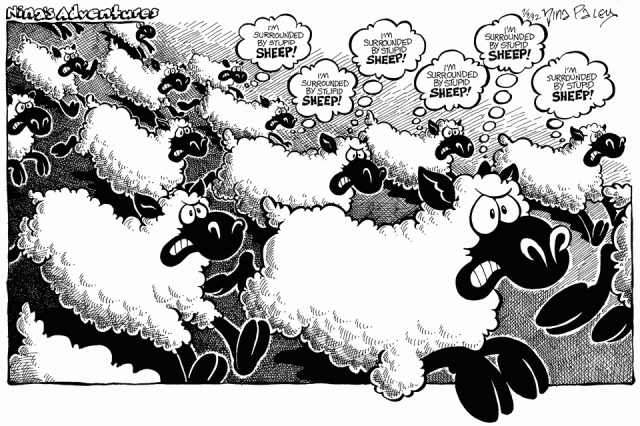Every Friday, 2 pm, Soy & Sake @ 47 7th Ave S (at Commerce St) in New York’s West Village. Open to anyone who is into Free Culture, Free Software, Free Speech, Intellectual Freedom, anti-censorship, etc.
YES we do this every week. Good times!
Animator. Director. Artist. Scapegoat.
YES we do this every week. Good times!
The Public Domain may not be growing (thanks to endless retroactive copyright term extensions) but it still contains a “whopping plentitude.” The biggest challenge to users is simply discovering PD works in the first place. Fortunately the Open Knowledge Foundation (one of the best Free Culture organizations anywhere) has just given everyone a leg up with its new web site, the Public Domain Review. From their About page:
The Public Domain Review aspires to become a bounteous gateway into the whopping plenitude that is the public domain, helping our readers to explore this rich terrain by surfacing unusual and obscure works, and offering fresh reflections and unfamiliar angles on material which is more well known.
Go there to find all kinds of delicious images, texts, sounds, and other treasures that, thanks to our collective cultural amnesia, are as fresh and exciting as anything Big Media tries forcing down our throats today.
Above: Princess Nicotine, and early stop-motion silent film, featured on The Public Domain Review.
After one or two (or more?) years of being blocked on German Youtube, the full-length noncommercial Sita Sings the Blues movie is once again viewable in Deutschland:
I assume this is because last week I posted this video, complaining about why my 100% legal and painstakingly and expensively licensed movie was blocked in Germany:
Apparently many Germans are none too pleased with GEMA themselves, as indicated by interesting comments here. Some industry shills weighed in as well, but it looks like popular sentiment is against them. The story was shared widely, including in Der Spiegel and the New York Times online editions.
It’s not clear how an American YouTube user is supposed to contest takedowns in Germany. When I was in Berlin recently, it was suggested I find a German lawyer to take some sort of action. At the very least, I would need someone in Germany to contest the takedown on my behalf. I imagine that would have been a slow and possibly expensive process. Then I thought of making this video. Although it took some work (writing a statement – yes I know it’s an imperfect statement, I did the best I could with the knowledge I had – shooting the video, recording the audio via a separate mic, transferring files, editing, compressing, etc.) it was less work than managing an international legal process. And it got results fast! Better still, it contributed to ongoing debates about GEMA and Intellectual Pooperty in general.
My thanks to everyone who helped spread the word about this, and especially people in Germany who checked the Sita Sings the Blues URL and confirmed when the movie was blocked, and when it was unblocked.
Addendum to Culture is Anti Rivalrous
Why do I say Culture is not a Commons?
Because a commons is a publicly or collectively owned good, and culture can’t be owned. Page 12 in Lewis Hyde’s Common As Air (see article on why air isn’t a metaphor I’d use) refers to “the old idea of ‘the commons’ as a way to approach the collective side of ownership.” Whoa there. We agree that Culture shouldn’t be privately owned, but where I differ is that Culture shouldn’t – and can’t – be owned at all. When we call Culture a commons we remain in the framework of culture-as-property, the framework of ownership.
But: Culture. Can’t. Be. Owned.
The correct answer to the question of “who owns culture?” is “no one.” Not Sony. Not “The Author.” Not “The Public.” No one owns Culture, because Culture isn’t property. So I prefer not to talk about it like it is property, or something that can be owned. So I don’t call it a commons.
Also, I wrote that real commons – real collectively owned goods – need to be regulated and/or managed, because they are rivalrous and/or scarce. Calling Culture a commons implies that it needs to be regulated and/or managed. That sometimes betrays an unexamined belief that copyright is “natural,” that private interests could somehow step in and “own” Culture without interference. But Copyright and cultural ownership are completely artificial, legal fictions, State-granted monopolies that can only exist if Culture is artificially (and misguidedly) “managed.” So again, calling Culture a Commons implies it needs to be “managed”, reinforcing the same mental framework that allows copyright and the private ownership of ideas to thrive.
I’m not going to fight against anyone calling Culture a commons. Most progressives do it, and we should be working together, blah blah etc. But I did want to clarify why I wrote that Culture is not a commons, since it may freak some people out. Sometimes I refer to “our shared cultural heritage,” which is about as close as I come to calling it a commons myself. Language is tough. For example, there’s no word for the opposite of property. Until there is, it may be difficult to wrap our heads around the idea that something actually isn’t property and can’t be owned, collectively or privately.
At least I can use the word anti-rivalrous now.
Economists talk about rivalrous and non-rivalrous goods, but Culture is neither rivalrous, nor non-rivalrous; it is anti-rivalrous.
Rivalrous goods diminish in value the more they are used. For example, a bicycle: if I use it, it gets me from here to there, if you use it, it gets me nowhere. If I acquire your bicycle, you don’t have it any more. Only one of us can have the bicycle at one time. We can share it to a limited extent, but the more it’s used the less it’s worth; it gets dinged up and wears out. The more people use the bicycle, the less utility it has.

All material things – things made of atoms – are rivalrous, because an object cannot be in two places at the same time. Everything in the physical world is rivalrous, even if it’s abundant.
A commons is a rivalrous good. Hence the “tragedy of the commons“: the more people use a square of land, the less valuable it is to each of them. The grass gets eaten too fast to grow back, the soil can’t handle the incoming rate of sheep shit, and degradation ensues.


Rivalrous and non-rivalrous are often confused with scarce and abundant, but they’re not the same thing. Air is abundant, but it is still rivalrous – some “users” could make it toxic for the rest of us, because air is not infinite. Land and water are so abundant in North America that Native Americans couldn’t imagine owning or depleting them, and look what happened. We treat the oceans as infinite, but they are not; human pollution and exploitation is killing ocean life. We also pollute the vast ocean of air – hence acid rain. Air and oceans are commons.
Commons are commonly-held rivalrous goods. Because they are rivalrous, some uses (or over-use) can poison them or otherwise diminish their value. For that reason, Commons(es) actually merit rules and regulations.
But Culture is not a commons, because Culture is not rivalrous and can’t be owned.
Non-rivalrous goods, as their name implies, don’t diminish in value the more they are used. A favorite example of a non-rivalrous good is the light from a lighthouse. It shines for everyone. No matter how much you look at it, I can see it too.

This is a pretty good example, but it’s not quite right. Theoretically, if enough tall boats are in the harbor, they actually can crowd out your lighthouse light.

Consider sunlight in Manhattan; yes, the sun shines for everyone, but if they build a high-rise next to your apartment you won’t see it any more. There’s only so much sunlight that hits a certain area, and that light is rivalrous. You can always move, of course – except land, while abundant, is definitely rivalrous and not infinite, so you’ll have to engage in some rivalry to do so.
The light metaphor has another problem: is light a particle, or a wave? If it’s a particle, then light is rivalrous. If it’s a wave, then it’s not.
 Thomas Jefferson used the example of candle fire, writing “He who receives an idea from me, receives instruction himself without lessening mine; as he who lights his taper at mine, receives light without darkening me.” Of course candles burn out but it’s not the light that’s diminished, it’s the candle. That’s a great metaphor for attention, which is scarce: once our attention is used up, the light goes out.
Thomas Jefferson used the example of candle fire, writing “He who receives an idea from me, receives instruction himself without lessening mine; as he who lights his taper at mine, receives light without darkening me.” Of course candles burn out but it’s not the light that’s diminished, it’s the candle. That’s a great metaphor for attention, which is scarce: once our attention is used up, the light goes out.
 But Culture is not non-rivalrous either.
But Culture is not non-rivalrous either.
Anti-rivalrous goods increase in value the more they are used. For example: language. A language isn’t much use to me if I can’t speak it with someone else. You need at least two people to communicate with language. The more people who use the language, the more value it has.
Which language do you think more people would pay to learn?
More people spend money and time learning English, simply because so many people already speak English.
Social networking platforms increase in value when more people use them. I use Facebook not because I love Facebook (I certainly don’t), but because everyone else uses Facebook. I just joined Google+, and will use that instead of Facebook if enough other people use it. If enough people flock to yet another platform, I’ll use that instead. Meanwhile I love Diaspora in principle (I was an early Kickstarter backer, before they surpassed their initial $ goal), but I don’t use it, because not enough other people do. When it comes to social networks, I am a sheep.

Culture is anti-rivalrous. The more people know and sing a song, the more cultural value it has. The more people watch my film Sita Sings the Blues, or read my comic strip Mimi & Eunice, the happier I’ll be, so please go do that now and then come back and read the rest of this paragraph. The more people know a movie or TV show, the more cultural value it has. Monty Python references attest to the cultural value of Monty Python – we even use the word “spam” because of it. Shakespeare‘s works are culturally valuable, and phrases from them live on in the language even apart from the plays (“I think she doth protest to much,” etc.). The more people refer to Monty Python and Shakespeare, the more you just gotta see em, amiright? Or not, it doesn’t matter whether you see them, you’re already speaking them. That all culture is a kind of language, I’ll leave for another discussion.
Cultural works increase in value the more people use them. That’s not rivalrous, or non-rivalrous; that’s anti-rivalrous.
I know what you’re gonna say now: “what about my credit card number? That doesn’t increase in value if it’s shared!!” That’s right, Einstein, because your credit card number is not culture. Here are two things that aren’t made of atoms and are nonetheless rivalrous:
1. Identity
2. Secrets
Identity is some mysterious mindfuck that my very smart friend Joe Futrelle says no one has satisfactorily defined yet. But whatever identity is, it’s rivalrous. If more people were named Nina Paley and had my home address and social security number, I’d be screwed. But that should highlight that my name, home address, and social security number aren’t culture. They may be information, but they’re not culture. They don’t increase in value the more they are used.
Secrets have power as long as they’re secrets. They lose their power when they are shared. When I become conscious of some secret that’s weighing on me, I share it with at least one other person (even if they are a confidante also sworn to secrecy): I can feel the secret’s power diffused just by the act of sharing. Notice I use “power” here instead of “value.” Secrets may be of little or no cultural value – most people don’t really care who that guy slept with 6 years ago – but they can certainly have power, especially when used for blackmail. Which is why it’s important they remain secrets, so they’re not used for blackmail, or harassment, or any reason at all. Privacy is important. Because secrets aren’t culture. Culture is public. Secrets are, well, secret. Until they’re public, whereupon we get scandalous stories that are culture – humans love to gossip – but aren’t secrets any more. The story might gain value, but the secret loses it.
Money vs. Currency
And how about money? Money is scarce, right? It has to be, or it doesn’t work (thanks Wall Street & Federal Reserve for screwing that up). But currency has more value the more it is used! Would you rather have your scarce 100 Euros in Euros, or in giant immoveable donut-like stones on a remote island?

I remember when the US dollar was a valuable currency; markets all over the world wanted dollars, because they were so widely used and exchangeable. So you want your money to be scarce, but you want your currency as widely used as possible.
It’s important to treat scarce goods as scarce, abundant goods as abundant, rivalrous goods as rivalrous, and so on. Wall Street treated money, a scarce and rivalrous good, as though it were infinite/non-rivalrous, and look what happened. Power companies, and the politicians they own, treat the environment, which is a rivalrous commons, as though it were non-rivalrous, and we have dying oceans and mass extinctions and other events you don’t want to think about so much that you’ll just get mad at me if I point them out here so I’ll stop. The RIAA and MPAA, and the politicians they own, treat Culture, which is anti-rivalrous, as though it’s rivalrous. They are doing for Culture what Wall Street did for the economy. If you want to help make this better, treat Culture like what it is: an anti-rivalrous good that increases in value the more it is used.
Addendum: Why do I say Culture is not a Commons?
High res video, audio (song), and stills at archive.org Crossposted at QuestionCopyright.org.
LYRICS:
Always give credit where credit is due
if you didn’t write it, don’t say it’s by you
just copy the credit along with the work
or else you’ll come off as an arrogant jerkAlways give credit where credit belongs
we know that you didn’t write Beethoven’s songs
pretending you did makes you look like a fool
unless you’re Beethoven – in that case, it’s coolA transparent system makes cheating unwise
the simplest web search exposes your lies
no one wants their reputation besmirched
which happens to liars when they are web-searchedProper citation will make you a star
it shows that you know that we know who you are
Plagiarization will only harm you
so always give credit where credit is due!
Synopsis:
Mimi makes a copy of a Beethoven Symphony with a giant copy machine. Trouble starts when Eunice erases Beethoven’s name and writes in her own. This makes Eunice look like an ass. Searching the Internet (itself a giant copy machine) confirms that Eunice is a liar. Eunice realizes her mistake and corrects it, but by then everyone’s moved on – her plagiarism is barely a blip in the spread of correctly-attributed cultural works through copying.
Explanation:
Whenever I speak about Free Culture at schools, I’m asked “what about plagiarism?” Copying and plagiarism are two quite different things. As Mimi demonstrates with the giant Copy Machine, copying a work means copying its attribution too:
just copy the credit along with the work
When people copy songs and movies, they don’t change the authors’ names. Plagiarism is something else: it’s lying. If Copyright has anything to do with plagiarism, it’s that it makes it easier to plagiarize (because works and their provenance aren’t public and are therefore easier to obscure and lie about) and increases incentive to do so (because copying with attribution is as illegal as copying without, and including attribution makes the infringement more conspicuous). American Copyright law does not protect attribution to begin with; it is concerned only with “ownership,” not authorship. Many artists sign their attributions away with the “rights” they sell, which is why it can be difficult to know which artists contributed to corporate works.
I chose Beethoven to illustrate how copyright has nothing to do with preventing plagiarism. All Beethoven’s work is in the Public Domain. Legally, you can take Ludwig van Beethoven’s songs, Jane Austen‘s novels, or Eadweard Muybridge‘s photographs and put any name you want on them. Go ahead! You’re at no risk of legal action. Your reputation may suffer, however, and you definitely won’t be fooling anyone. If anyone has doubts, they can use that same copy machine – the Internet – to sort out who authored what. Lying is very difficult in a public, transparent system. A good analog to this is public encryption keys: their security comes from their publicity.
The song says “always give credit where credit is due,” but in many cases credit is NOT due. For example, how many credits should be at the end of this film? I devoted about two and a half seconds to these credits:
Movie and Song by Nina Paley
Vocals by Bliss Blood
But I could have credited far more. In fact, the credits could take longer than the movie. Here are some more credits:
Ukelele: Bliss Blood
Guitar: Al Street
Recorded by Bliss Blood and Al Street
What about sound effects? Were it not for duration constraints, this would be in the movie:
Sound Effects Design by Greg Sextro
Every single sound effect in the cartoon was made by someone. Should I credit each one? Crash-wobble by (Name of Foley Artist Here). Cartoon zip-run by (Name of Other Foley Artist Here). And so on: dozens of sound effects were used in the cartoon, and each one had an author. What about the little noises Mimi & Eunice make? Not only could the recording engineer be credited, but the voice actor as well (as far as I know, these were both Greg Sextro).
I included a few seconds of Beethoven’s Fifth Symphony at the end, which I didn’t credit in the movie. Should I have? Why or why not?
I could credit the characters:
Starring:
Mimi
Eunice
& Special Guest Appearance by
Ludwig van Beethoven
I could be more detailed in crediting myself:
Lyrics and Melody by Nina Paley
Character design: Nina Paley
Animation: Nina Paley
Produced by Nina Paley
Directed by Nina Paley
Edited by Nina Paley
Backgrounds by Nina Paley
Color design by Nina Paley
Layout: Nina Paley
Based on the comic strip “Mimi & Eunice” by Nina Paley
And the funder!
This Minute Meme was funded by a generous grant from the Andy Warhol Foundation for the Visual Arts
I didn’t even make a card for the Minute Memes logo. Should that be in there?
I used a Public Domain painting of Beethoven for the Beethoven character, which is by Joseph Karl Stieler. Who photographed the painting? Who digitized the photograph? Is credit due here?
The ass drawing also came from Wikimedia Commons, where it’s credited to Pearson Scott Foresman. But who actually drew it? I have no idea. I doubt that Pearson Scott Foresman could even legally claim the copyright on it to “donate” to Wikimedia in the first place, but there they are, getting credit for it instead of an artist. That’s because copyright is only concerned with “ownership,” not authorship.
 Then there’s the software I used, good old pre-Adobe Macromedia Flash. Should I credit the software? What about the programmers who contributed to the software?
Then there’s the software I used, good old pre-Adobe Macromedia Flash. Should I credit the software? What about the programmers who contributed to the software?
I also used a Macintosh computer (I know, I know, when Free Software and Open Hardware come close to doing what my old system does, I’ll be the first to embrace it) and a Wacom Cintiq pen monitor. How many people deserve credit for these in my movie?
Mimi and Eunice themselves were “inspired” by many historical cartoons. Early Disney and Fleischer animations, the “rubber hose” style, Peanuts, this recent cartoon, and countless other sources I don’t even know the names of – but would be compelled to find out, if credit were in fact due. Is it?
And so on. It is possible to attribute ad absurdum. So where is credit due? It’s complicated, the rules are changing, and standards are determined organically by communities, not laws. I had to edit the song for brevity, but I kind of wish I hadn’t excised this line:
A citation shows us where we can get more
of all the good culture that Free Culture’s for
Attribution is a way to help your neighbor. You share not only the work, but information about the work that helps them pursue their own research and maybe find more works to enjoy. How much one is expected to help their neighbor is determined by (often unspoken) community standards. People who don’t help their neighbors tend to be disliked. And those who go out of their way to deceive and defraud their neighbors – i.e. plagiarists – are hated and shunned. Plagiarism doesn’t affect works – works don’t have feelings, and what is done to one copy has no effect on other copies. Plagiarism affects communities, and it is consideration for such that determines where attribution is appropriate.
At least that’s the best I can come up with right now. Attribution is actually a very complicated concept; if you have more ideas about it, please share.